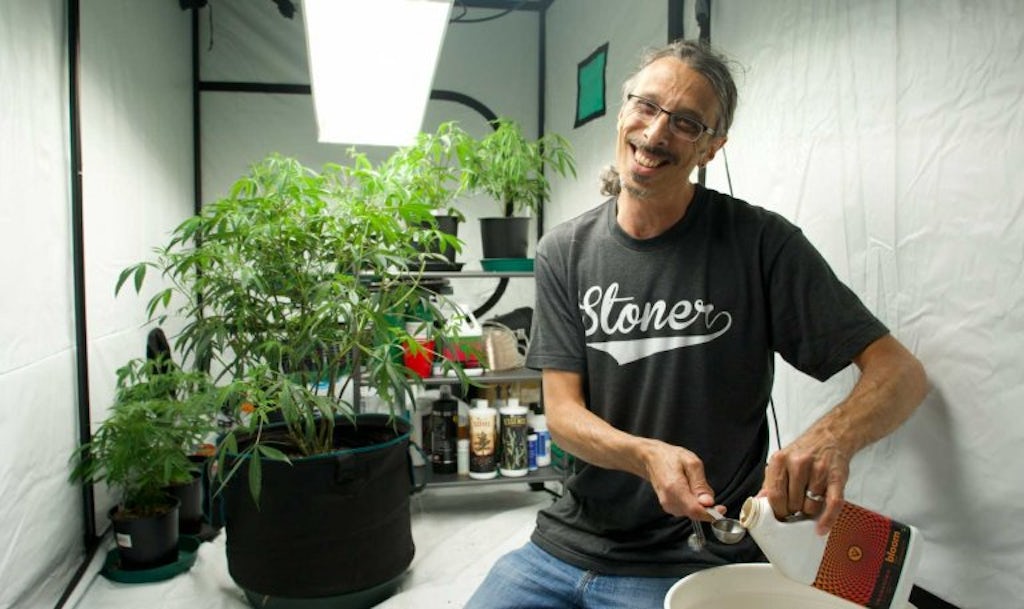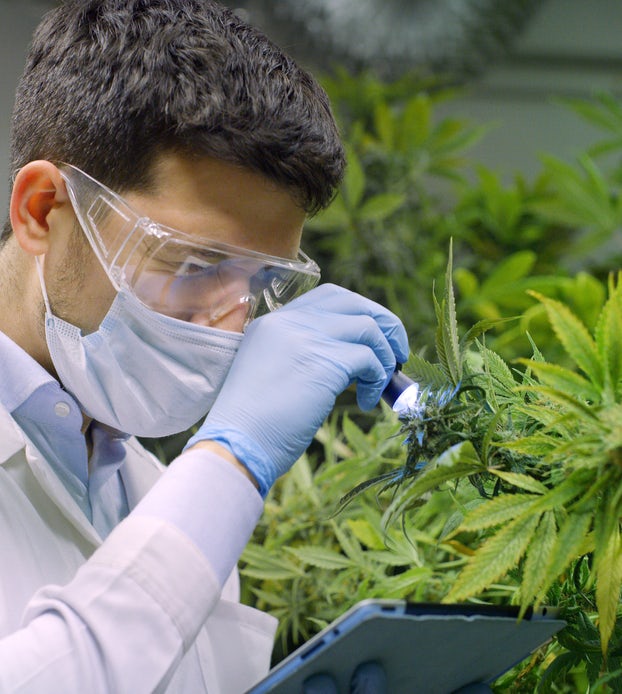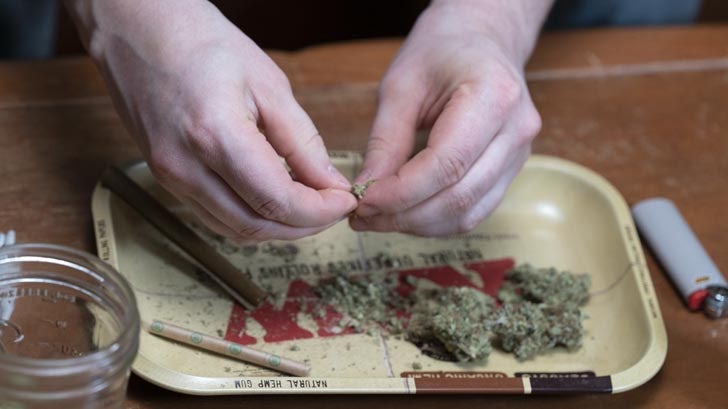With a green glass bong in hand, Kyle Kushman leans forward on his couch at his home somewhere in LA County and marvels at how his life story became a stoner film whose last act has yet to be written.
“Growing pot and [that] becoming my career, there’s a movie in there somewhere. There’s gotta be a movie in there somewhere,” he says.
Long before he became the legendary cannabis cultivator behind powerhouse strains like Strawberry Cough, he was Adam Orenstein, a nice Jewish boy from Long Island. The son of an English teacher and a homemaker, he is the youngest of three brothers.
“One’s a lawyer and the other one is a psychoanalyst. I’m the black sheep of the family,” Kushman laughed.
From Orenstein to Kushman: How a cannabis cultivation icon was born
Born in Commack, Long Island in 1966, Orenstein grew up in Mohegan Lake in Westchester County, New York until he joined the army at age 17. Luckily for the world of weed, he “got serviced out” two years later.
It was the mid-80s, and in Mt. Laurel, New Jersey, Orenstein would soon start perfecting his trade as a pot farmer.
“My two-minute elevator progression story is that I’m a weed dealer. My guy who sold me weed said ‘let me use your closet, your walk-in closet and I’ll teach you how to grow.’ He brings over a little grow system and a light and some pool test strips and a blue powder and a green powder.”
It wasn’t long before Kushman said he had his Road to Damascus moment.
“The first buds I ever grew were the size of soda cans and I literally said to myself, ‘your life is never going to be the same.’ I had cut out the middle man, I was growing my own weed!”
Today, pushing 55 years old, his eyes still seem to marvel when he recounts the sight of those artillery shell colas he first grew with his own hands.
Enter the Kushman

Often erroneously thought to be the inventor of Kush, Kyle Kushman is a cannabis cultivator known across the world of weed, and he has the trophy case to prove it. Kushman has won 13 medical Cannabis Cup awards, including three US Cannabis Cups in the Best Flower category, which he won using his very own award-winning “Vegamatrix” vegan and organic plant nutrients.
Kushman taught advanced horticulture at Oaksterdam University in Oakland, California and in the fall he says Dark Heart Nursery will be releasing clones of three of his legacy strains for the California commercial market. Somewhere along the way he’s also finding time to work on a new TV series for Social Club TV, tentatively titled “From Seed to Smoke.”
Kushman is probably best known for the two decades he spent as a cultivation reporter and contributing writer at High Times, another twist that happened by chance. Kushman says he was living in New Paltz, NY, and would often visit a tie dye shop in town when one day the owner asked him if he wanted to step outside to smoke a joint.
Kyle pulled out some of the Purple Kush he’d grown from the seeds his dealer gave him, and the Earth stood still for a moment.
“You know that scene in [Who Framed] Roger Rabbit when he sees Jessica Rabbit and his eyes pop out, I swear it was like that and he said, ‘where’d you get that?’”
The two became friends and the shop owner introduced Kushman to some people he knew at High Times, who Kushman then introduced to the dynamite Purple Kush herb he was growing. Kushman says the purple dank with the big magenta pistils was enough to floor even the veteran cannabis editorial staff at High Times, who started photographing Kushman’s weed for the magazine and making good use of his connections in the underground cultivation scene.
When he’d come by the office, the receptionist would call out “the Kush Man is here, the Kush Man is here,” which provided some inspiration. But really, he says, he wanted the perfect pen name and Kushman just made sense.
“I wrote my first story and I needed a pseudonym and I didn’t want to be Herb Green or Bud Levy or some pot name. I tried to think of a name that would sound like a real person for if I was in line at customs and someone yelled out hey Kushman! So I was like, I’m growing Kush, Kyle Kushman, it sounds like a Jewish orthopedist! Kushman, my bunions are killing me! So I became Kyle Kushman and I wrote my first story.”
Kyle Kushman quickly learned that growing weed was more lucrative than writing about it, however.
“The funny thing is when I got that High Times job I remember thinking this could be it, I could be a journalist for 20 years! I could retire with a pension and have a legitimate job, and I soon found out that starving journalist wasn’t just a saying.”
Kushman would become an institution at the magazine and in the world of cannabis cultivation, before heading out west in 2004 to grow weed legally in California.
This week, while taking a break from tending a small grow of his legacy strains Strawberry Cough, Grape Ape, and Starberry, Kushman took some time to tell The Cannigma what he thinks of the legal cannabis industry, what types of weed he loves, and shared some tips for novice weed growers.
‘The bean counters are killing marijuana’

Asked how cannabis has changed now that it’s become mainstream and legal in states across the country, Kushman doesn’t mince words.
“It’s McDonald’s and it’s Bed Bath and Beyond,” he says, adding that “bean counters and stockholders” have taken over the landscape, with a focus only on the bottom line and finding ways to lasso the next flash in the pan cannabis trend.
“Now, you put it on the shelf and everyone wants Cookies and Cream because they heard about it on Instagram or TikTok and if you don’t have Cookies and Cream then they go somewhere else to buy it and that’s what’s driving the market.”
Kushman calls himself a connoisseur of cannabis and agrees that there is an arms race over the potency of the herb that goes on the shelf today.
“It has to be the highest THC, it has to be easy to grow, it has to be all these criteria that didn’t matter to a real grower, but now matter to the commercial grower.”
But even when he’s critical, there’s no venom in Kushman’s words. He sees himself as “a medicine man” and says he isn’t looking to get rich or put anybody down.
“It’s not that they’re growing bad weed, it’s just that they’re growing weed with no soul, and what I mean is they are growing with rocket fuel and steroids because the bottom line is more important.”
He clearly just loves cannabis, loves growing it, loves talking about it, and seems to be constantly spellbound by the known and unknown benefits of the plant even after decades spent between the rows. At times, he almost sounds like a protective parent when it comes to herb.
“To keep the culture alive is everything, he says. “To keep cannabis from becoming a clear odorless liquid in a vaporizer with no taste or added strawberry flavor like lucky charms or something, it’s going to take people like myself.”
The natural product — cannabis flower — is always superior in his eyes, and that its medicinal value diminishes the further we get from it.
“I wouldn’t focus so much on concentrates and vape pens. I believe that just like food we know that the more you process a food stuff the less healthful it becomes. I believe that the more you process cannabis the less healthful it becomes.”
Kushman’s guide to good and bad weed

How does the master grower tell if he’s got some good or bad weed on his hands?
“I know instantly on the throat and then I won’t take another hit. My throat is snobbed out to the max,” he says.
Kushman blames bad weed on the additives that cultivators use, saying “it’s garbage in and garbage out,” and that “plants are made up of the soul, the essence of everything they’ve consumed, and there’s no essence of potassium nitrate.”
Kushman said he wants to see a move away from hybrid strains and towards “old school strains” that were more purely indicas or sativas.
The old school genetics “that we know are better than these hybrids. They get you high for twice as long as these hybrids and I think that incorporating more lessons and knowledge of the cannabis culture into the long-term business model would be beneficial for everybody.”
“Nothing is an indica and nothing is a sativa anymore,” he continues. “When you smoke you want the perfect daytime weed and you want the perfect nighttime weed, and hybrids don’t do either of those, not for me anyway.”
Kushman said all of this while holding a bong fully loaded with a fat bowl of Strawberry Cough, which is itself a sativa-dominant hybrid, though much more heavily sativa than most of the “balanced” hybrids of today.
And what would he smoke if he could only smoke two or three strains for the rest of his life?
“A hash plant or a G13 or a really strong indica or grape ape. But the thing is I wouldn’t choose to only smoke two or three, I would like to be able to rotate them and have them all be either an indica dominant or a sativa-dominant and not a 60-40 hybrid. They just don’t do it for me.”
Kyle Kushman’s tips for cannabis growers
Kushman appears to have a share-the-wealth approach that may have more typified the days when cannabis was a subculture and no weed dealers were listed on the NASDAQ.

On the video call from his living room, he was more than happy to share his weed growing tips.
- Be patient
“I think the most important thing to grasp when you’re gardening anything is patience. The plant has evolved by the sun revolving around the earth for millennia. And there’s very little if anything you can do to speed it up.”
- Focus on having healthy plants
“I always tell people learn how to grow healthy plants. Don’t focus on yield or quality, focus on learning how to grow healthy plants because the healthiest plants generally tend to yield the most, and are the most potent. And the thing is people want to do things. You know, like a puppy — you want to train it and have it learn new tricks. A plant is not a puppy and you can’t teach it to do new tricks every day.”
- Observation is key
“You have to learn the language of the plant and that takes observation. Observation is key. If you don’t spend time observing the plant you can’t become a master cultivator.”
- Water and nutrients
“Focus on learning to water and how to nutrify your plants. And then after that, if you’re doing indoor gardening you can look at the environment.”
- Make sure you have the right grow environment
“Learn the plant and what it tells you when you do something good and what it shows you when you do something bad. The better the control you have over your environment the more you’ll be able to eventually slap the plant around and get it to jump through hoops for you. But you gotta do those things first.”
- Don’t try to do too much
“I’ve seen first time growers grow amazing, sugary, sparkling weed the very first time. As soon as they think they know something they get cocky,” Kushman said, adding that users should only learn or add one new technique at a time. “Grow for at least a year with one method, one nutrient system before you start changing it up.”
- You only have so much control
With all the grow tips that he has amassed over the past few decades, Kushman said ultimately, we all have to stay humble and understand that nature is more of a factor than nurture. “Genetics is everything. Genetics is 90% of the equation, the grower is 10%. You maybe have 10% that you can affect with that plant in a good way if you’re really attentive and really good.”
- Don’t overthink things
“The plant does most of the work, you just have to take care of the plant. I mean, there’s no Child Protective Services for plants. You’re not going to go to jail if you kill it. It’s pretty commitment free.”
- Buy great seeds
If genetics are 90% of the game, then it makes sense to buy seeds with a proven pedigree. And if they’ve been endorsed or bred by a cultivator like the Kushman, then you’re already going to boost your chances in a major way.
On Homegrown Cannabis, you can find seeds for Kushman-bred strains like Strawberry Cough and cannabis mainstays like Blueberry or a feminized version of 2020 Leafly strain of the year Runtz. Of course, you could also just try your hand at growing your own Purple Kush, and see if it opens the door to a lifelong personal cannabis saga that you never saw coming.
Sign up for bi-weekly updates, packed full of cannabis education, recipes, and tips. Your inbox will love it.

 Shop
Shop Support
Support
















